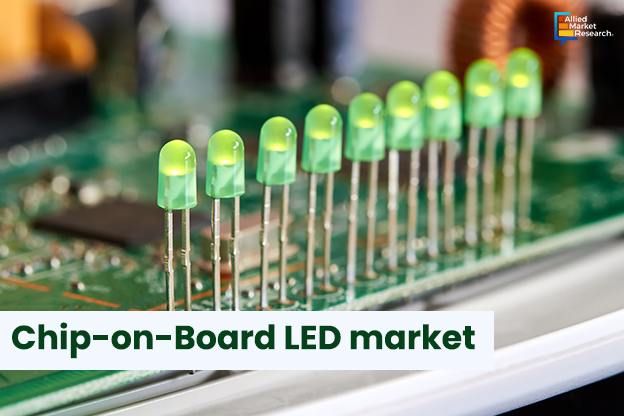A Comparative Analysis of Chip-On-Board (COB) LEDs and Surface Mounted LEDs

6 Oct
2023
The term “chip-on-board" refers to direct connection to the substrate. Thus, chip-on-board LEDs refer to light emitting diodes that are connected directly to the substrate so that the circuit module forms a single structure of LED arrays. Contrary to this, surface mounted LEDs are mounted on one side of the circuit board by soldering using mounting technology.
Chip-on-board (COB) LEDs vs. surface mounted LEDs
Of all the LED lighting technologies available in the consumer electronics industry, chip-on-board LED and surface mounted LED technologies are the most popular. The most basic difference between the two types is in the size. COB LEDs are much larger in size while surface mounted LEDs are much smaller. However, since LEDs are arranged in the form of arrays in chip-on-board technology, the circuitry contains much more light sources in the same surface area as compared to other technologies. Also, spot soldering of each LED isn’t necessary in the case of chip-on-board LEDs as they are directly attached to the substrate. This brings down the failure rate of these LEDs substantially.
Apart from these differences, chip-on-board LEDs and surface mount LEDs also differ in terms of beam angle and light output. The beam angle of COB LEDs is much wider as compared to surface mounted LEDs which is why the light output of COB LEDs is more uniform and the light diffuses over a larger area. Hence, COB LEDs are used to illuminate larger areas, while surface mounted LEDs are used where the lighting needs to be more focused. Also, COB LEDs offer a high thermal performance, thereby ensuring higher reliability and stability of the entire circuitry. However, the ability of COB LEDs to alter colors is lesser as compared to surface mounted LEDs. Both the types of LEDs are highly energy efficient, though COB LEDs fare somewhat better in this aspect too.
Important factors affecting the growth of the market
The chip-on-board LED market, as per a report by Allied Market Research, is expected to witness huge growth in the 2023-2032 timeframe. The report cites that there are several drivers and factors that will influence the market in the years to come. Growing demand for and adoption of COB light emitting diodes in residential and commercial applications is the primary reason for the growth of this market. Moreover, local authorities in different countries are opting for COB LEDs for street lighting and backlighting applications which is further increasing the demand for these lighting systems. In the past few years, it has been seen that several manufacturing industries, too, are opting for COB LED lighting systems. This has led to a massive surge in demand which will expand the scope of the market.
Another important factor which is expected to play an instrumental role in the growth of this market is the launch of several products by leading companies in the industry. Companies like Sharp, Taiwan Chipex Electronic Co, Osram Opto Semiconductors, etc., have launched advanced LED lighting systems in the market which have garnered a lot of attention and demand from the global consumer base. For instance, in April 2023, Sharp NEC Display Solutions, a leading display and signage solutions provider, announced the launch of NEC LED FC Series with Chip on Board (COB) technology.
In summary, the chip-on-board LED market is anticipated to experience huge growth due to its advantages over other traditional LED lighting systems. Moreover, growing adoption from residential, industrial, and commercial sectors will help the market to continue on its current growth trajectory.

Koyel Ghosh
Author’s Bio- Koyel Ghosh is a blogger with a strong passion and enjoys writing in miscellaneous domains, as she believes it lets her explore a wide variety of niches. She has an innate interest in creativity and enjoys experimenting with different writing styles. A writer who never stops imagining, she has been serving the corporate industry for the last five years.
Traversing Unprecedented Benefits and Applications Power Over Ethernet (Poe) Lighting Driving Industries Worldwide
Avenue: Entire Library membership of Allied Market Research Reports at your disposal
- Avenue is an innovative subscription-based online report database.
- Avail an online access to the entire library of syndicated reports on more than 2,000 niche industries and company profiles on more than 12,000 firms across 11 domains.
- A cost-effective model tailored for entrepreneurs, investors, and students & researchers at universities.
- Request customizations, suggest new reports, and avail analyst support as per your requirements.
- Get an access to the library of reports at any time from any device and anywhere.
Related Post
-
How are Submarine Cables Transforming Global Connectivity with Enhanced User Experience?
-
Endoscopy Procedures: Transformations in Techniques and Applications
-
AI-Powered Video Analytics: How the Product Actually Works for enterprises
-
Painting Robots: Transforming Precision Coating and Creative Applications
-
Innovations in Pharmacovigilance Systems Advancing Patient Safety
-
Understanding Edge Security: Keeping Data Safe Near the Source
-
Exploring the Use and Advancements of 3D Laser Scanners in Professional Applications
-
Reinforcing Industrial Controls with Smarter Tools and Training








